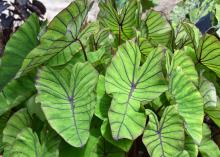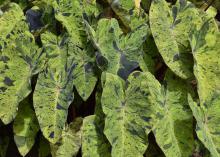Information Possibly Outdated
The information presented on this page was originally released on June 8, 2015. It may not be outdated, but please search our site for more current information. If you plan to quote or reference this information in a publication, please check with the Extension specialist or author before proceeding.
Elephant ears create a tropical paradise
Tropical plants, like elephant ears, just scream for attention and attract interest in any landscape. Most gardeners love elephant ears because they are easy-to-grow tropical plants that make a big impact.
There are three species commonly found in Mississippi landscapes: Alocasia, Colocasia and Xanthosoma. Colocasia is my favorite elephant ear variety and the focus of this column. Most Colocasia plants feature big leaves and big texture, but they’re not all green. In fact, there are Colocasia varieties with black leaves.
Diamond Head is an outstanding Colocasia with foliage that is black and lustrous, just like its namesake volcanic cone on the island of Oahu. The huge foliage is at least 16 inches long and more than a foot wide. For the darkest color development, grow Diamond Head in the full sun. The leaves are a dark green if grown in the shade. Maintain consistent moisture or the leaf edges will burn and turn a crinkly brown.
Black Coral has large, chocolate-black leaves with finely ruffled edges. The thick, black stems display the glossy arrow-shaped leaves, which are some of the darkest available on the market. The individual leaf surfaces have a corrugated appearance and have prominent deep-blue veins. Black Coral is a great choice for a landscape focal point, reaching up to 4 feet tall. Like other Colocasia selections, these plants grow great in large containers with a consistent supply of summer moisture.
Blue Hawaii is another wonderful Colocasia variety. This plant has large green leaves featuring prominent bluish-purple veins. The edges are also bluish-purple and have a wavy undulation. The dark-burgundy petioles are glossy. Blue Hawaii has a tight clumping growth habit that is perfect for smaller areas in the landscape or containers on the patio.
If you appreciate a cool mojito after a hot day working in the garden, you will find Colocasia Mojito is a plant that lives up to its name. Each of its splendid leaves resembles an avant-garde artist’s canvas. The unique color patterns of lime green, chartreuse, purple and almost black are randomly splattered and splotched so that no two leaves are the same. I think the pattern colorations are intensified when the plant is grown in the partial shade.
Colocasia will overwinter most years without any cold protection all across Mississippi. In really cold weather, the central root structure may freeze and rot. Ironically, the small side shoots that are produced each year will often survive even these coldest conditions. To be on the safe side, especially in northern parts of the state, mulch your Colocasia each year. Always wait until after the first frost and use shredded leaves or other mulching materials to add a layer of protection.
Going to the tropics may not be possible, but we still can enjoy the environment with Colocasia in our gardens.










